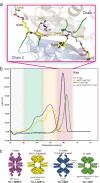Allosteric mechanism of pyruvate kinase from Leishmania mexicana uses a rock and lock model
- PMID: 20123988
- PMCID: PMC2857090
- DOI: 10.1074/jbc.M109.079905
Allosteric mechanism of pyruvate kinase from Leishmania mexicana uses a rock and lock model
Abstract
Allosteric regulation provides a rate management system for enzymes involved in many cellular processes. Ligand-controlled regulation is easily recognizable, but the underlying molecular mechanisms have remained elusive. We have obtained the first complete series of allosteric structures, in all possible ligated states, for the tetrameric enzyme, pyruvate kinase, from Leishmania mexicana. The transition between inactive T-state and active R-state is accompanied by a simple symmetrical 6 degrees rigid body rocking motion of the A- and C-domain cores in each of the four subunits. However, formation of the R-state in this way is only part of the mechanism; eight essential salt bridge locks that form across the C-C interface provide tetramer rigidity with a coupled 7-fold increase in rate. The results presented here illustrate how conformational changes coupled with effector binding correlate with loss of flexibility and increase in thermal stability providing a general mechanism for allosteric control.
Figures



Similar articles
-
The structure of pyruvate kinase from Leishmania mexicana reveals details of the allosteric transition and unusual effector specificity.J Mol Biol. 1999 Aug 20;291(3):615-35. doi: 10.1006/jmbi.1999.2918. J Mol Biol. 1999. PMID: 10448041
-
A Molecular Dynamics Study of Allosteric Transitions in Leishmania mexicana Pyruvate Kinase.Biophys J. 2015 Sep 15;109(6):1149-56. doi: 10.1016/j.bpj.2015.05.040. Epub 2015 Jul 22. Biophys J. 2015. PMID: 26210208 Free PMC article.
-
The putative effector-binding site of Leishmania mexicana pyruvate kinase studied by site-directed mutagenesis.FEBS Lett. 2002 Mar 13;514(2-3):255-9. doi: 10.1016/s0014-5793(02)02374-8. FEBS Lett. 2002. PMID: 11943161
-
The allosteric regulation of pyruvate kinase.FEBS Lett. 1996 Jun 24;389(1):15-9. doi: 10.1016/0014-5793(96)00462-0. FEBS Lett. 1996. PMID: 8682196 Review.
-
Modulation of allostery of pyruvate kinase by shifting of an ensemble of microstates.Acta Biochim Biophys Sin (Shanghai). 2008 Jul;40(7):663-9. doi: 10.1111/j.1745-7270.2008.00445.x. Acta Biochim Biophys Sin (Shanghai). 2008. PMID: 18604458 Free PMC article. Review.
Cited by
-
In-silico Leishmania target selectivity of antiparasitic terpenoids.Molecules. 2013 Jul 3;18(7):7761-847. doi: 10.3390/molecules18077761. Molecules. 2013. PMID: 23823876 Free PMC article.
-
The contribution of two isozymes to the pyruvate kinase activity of Vibrio cholerae: One K+-dependent constitutively active and another K+-independent with essential allosteric activation.PLoS One. 2017 Jul 7;12(7):e0178673. doi: 10.1371/journal.pone.0178673. eCollection 2017. PLoS One. 2017. PMID: 28686591 Free PMC article.
-
A new family of covalent inhibitors block nucleotide binding to the active site of pyruvate kinase.Biochem J. 2012 Nov 15;448(1):67-72. doi: 10.1042/BJ20121014. Biochem J. 2012. PMID: 22906073 Free PMC article.
-
Structures of Leishmania Fructose-1,6-Bisphosphatase Reveal Species-Specific Differences in the Mechanism of Allosteric Inhibition.J Mol Biol. 2017 Oct 13;429(20):3075-3089. doi: 10.1016/j.jmb.2017.08.010. Epub 2017 Sep 4. J Mol Biol. 2017. PMID: 28882541 Free PMC article.
-
Redox regulation of pyruvate kinase M2 by cysteine oxidation and S-nitrosation.Biochem J. 2018 Oct 31;475(20):3275-3291. doi: 10.1042/BCJ20180556. Biochem J. 2018. PMID: 30254098 Free PMC article.
References
Publication types
MeSH terms
Substances
Associated data
- Actions
- Actions
- Actions
- Actions
Grants and funding
LinkOut - more resources
Full Text Sources

